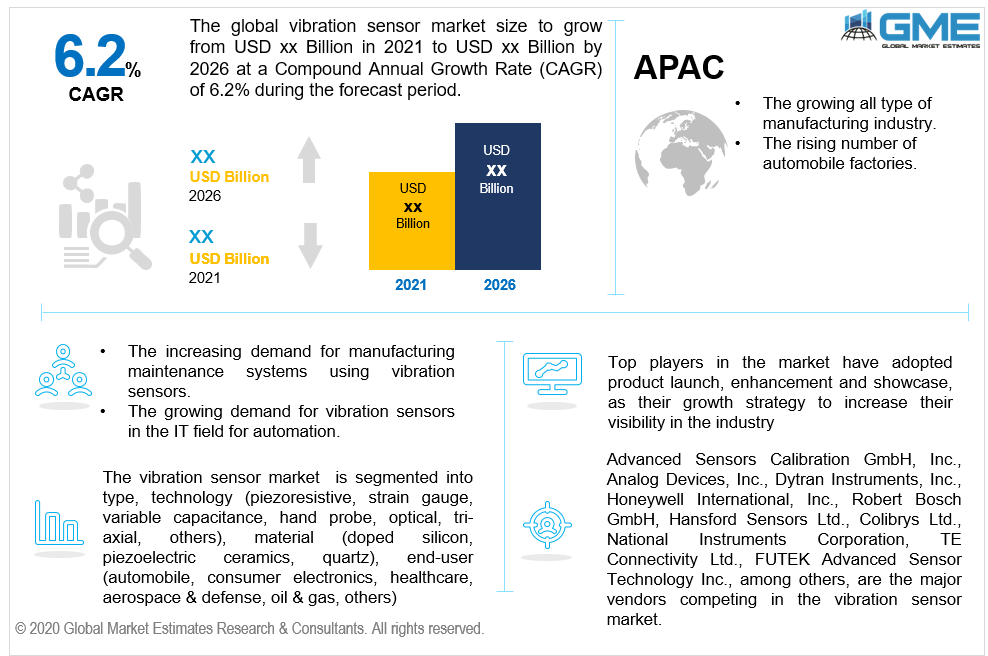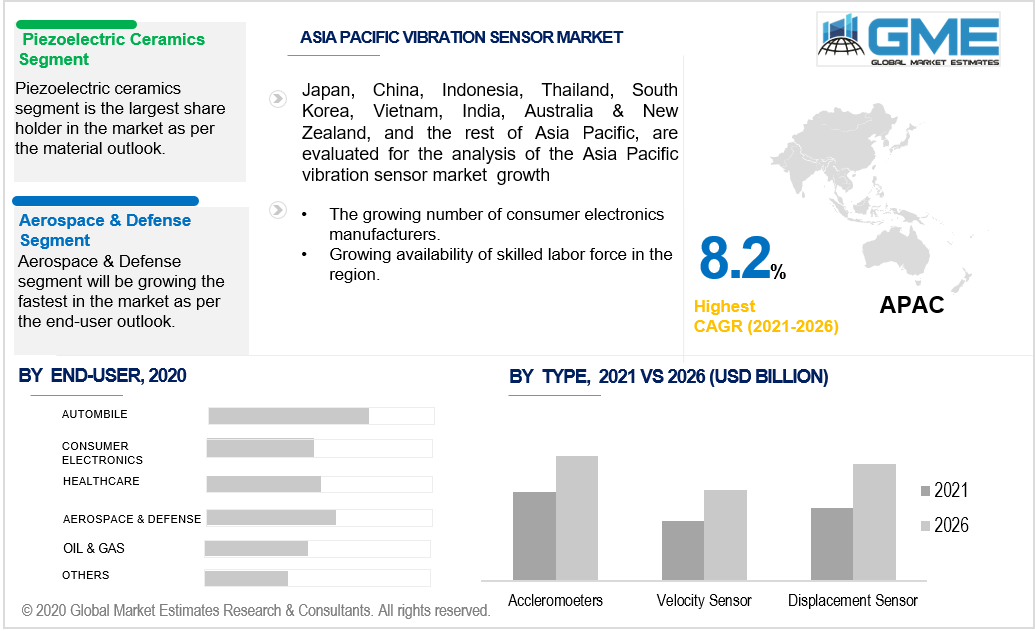
Global Vibration Sensor Market Size, Trends, and Analysis - Forecasts To 2026 By Type (Accelerometers, Velocity Sensor, Displacement Sensor), By Technology (Piezoresistive, Strain Gauge, Variable Capacitance, Hand Probe, Optical, Tri-axial, Others), By Material (Doped Silicon, Piezoelectric Ceramics, Quartz), By End-User (Automobile, Consumer Electronics, Healthcare, Aerospace & Defense, Oil & Gas, Others), By Region (North America, Asia Pacific, CSA, Europe, and the Middle East and Africa), End-User Landscape, Company Market Share Analysis & Competitor Analysis
Vibration sensors are used to measure the frequency of vibration occurring in a system, machine, or equipment parts. The growing demand for maintenance and monitoring of machinery and equipment as they operate is expected to increase the demand for vibration sensors in the market. The vibration sensors market has been growing steadily in recent years as these vibration sensors are used in various applications like monitoring and maintenance of machinery, monitoring bridges, buildings, and are even used to predict the occurrence of natural disasters like earthquakes. Vibration sensors can help machine maintenance staff to carry out maintenance of machinery before they break down and cause additional cost and labor. Vibration sensors are becoming increasingly popular in information and communication technology industries like IoT, machine learning, cloud-based systems, and wireless sensor networks. These technologies are being combined with machinery and equipment to automate the process of monitoring and predictive maintenance of machinery and equipment in automated production processes. Vibration sensors are being used in energy harvesting systems that convert vibrations into electrical energy. Manufacturing industries and automobiles use vibration harvesting systems to convert vibrational energy into electrical energy from the vibrations created when the machinery or automobile is operating. The electricity generated from the vibrations is then used to power the vibration monitoring systems to monitor the vibrations from the machinery or automobiles. This increased application of vibration sensors in vibration energy harvesters has increased the demand for vibration sensors and has had a positive impact on the vibration sensor market. For monitoring the railway tracks, vibration sensors come into the picture. Vibration sensors are used to detect the issues present in railways like breaks in rails, disjointed railway tracks, and the presence of obstructions on the railway tracks. Amid the process of creating and launching novel railway monitoring systems, the market has witnessed rising interest in vibration sensors.

Based on the materials that are used to make vibration sensors, the vibration sensor market can be segmented into doped silicon, piezoelectric ceramics, and quartz. Piezoelectric ceramics are expected to hold the dominant share of the market during the forecast period. Piezoelectric ceramic-based sensors have very good sensitivity to low charges of electricity and offer good noise reduction which reduces the interference and unwanted signals from the sensors. They are used extensively in the automobile industry to make wheel balancing machines to correct wheel imbalances that can be read as vibrations. Recently, piezoelectric ceramic-based sensors are being used in creating musical equipment. Piezoelectric ceramic-based sensors are lightweight compared to materials like quartz which have facilitated the usage of these sensors in accelerometers.
Based on type, the vibration sensor market can be segmented into accelerometers, velocity sensors, and displacement sensors. The accelerometers segment is expected to hold the lion’s share of the market during the forecast period. Accelerometers enjoy a large share of the market due to their widespread use in automobiles, consumer electronics, and manufacturing industries. Accelerometers are extensively used in consumer electronics. They are present in every smartphone or tablet device to detect the orientation of the device. This increased usage in consumer electronics has led to a large share of the accelerometer segment. They are also used in consumer electronics to detect whether the device is falling or has been dropped. The displacement sensors market is expected to grow at the fastest CAGR during the forecast period. Displacement sensors are becoming increasingly prevalent in detecting stacked printed circuit boards, automatic doors in elevators and vehicles, among others which are expected to further increase the demand for displacement sensors in the market.
Based on technology, the vibration sensor market can be segmented into piezoresistive, strain gauge, variable capacitance, hand probe, optical, tri-axial, and others. The piezoresistive segment is expected to hold the dominant share of the market. Piezoresistive vibration sensors are smaller and have greater sensitivity which has contributed to the dominance of the piezoresistive segment. They are used in automotive safety devices like anti-lock braking systems, and airbags, among others.
Based on the various end-users of vibration sensors, the vibration sensor market can be segmented into automobile, consumer electronics, healthcare, aerospace & defense, oil & gas, and others. The automotive segment is expected to hold the lion’s share of the market during the forecast period. Increased usage of vibration sensors in various aspects of automobiles like safety devices, balancing machinery, among others has led to the dominance of the automobile segment. The aerospace and defense segment is expected to grow at the fastest rate during the forecast period. Vibration systems are beginning to be used as system health monitors in aircraft, predictive maintenance of engines, and other applications in the aerospace and defense sector is expected to increase the demand for vibration sensors in this sector.

The North American region held the dominant share of the market. The region has a large number of railway networks, the use of vibration sensors for railway monitoring has resulted in the dominance of vibration sensors in the region. The APAC region is expected to register the fastest growth rate during the forecast period. Growing manufacturing industries in the region are expected to increase the demand for vibration sensors for machine maintenance and monitoring systems. Countries like China and India are two of the largest producers of automobiles in the world, growing usage of vibration sensors in the automobile sector is another factor that will increase the demand for vibration sensors in the region. Global electronic consumer companies are shifting their manufacturing and assembly factories to countries like China and India which will also increase the demand for vibration sensors in the region.
Colibrys, Dytran Instruments, Analog Devices, FUTEK, Robert Bosch, Honeywell, Hansford Sensors, National Instruments Corporation, Advanced Sensors Calibration, TE Connectivity, among others, are the major vendors competing in the vibration sensor market.
Please note: This is not an exhaustive list of companies profiled in the report.
We value your investment and offer free customization with every report to fulfil your exact research needs.
The Global Vibration Sensor Market has been studied from the year 2019 till 2026. However, the CAGR provided in the report is from the year 2021 to 2026. The research methodology involved three stages: Desk research, Primary research, and Analysis & Output from the entire research process.

The desk research involved a robust background study which meant referring to paid and unpaid databases to understand the market dynamics; mapping contracts from press releases; identifying the key players in the market, studying their product portfolio, competition level, annual reports/SEC filings & investor presentations; and learning the demand and supply-side analysis for the Vibration Sensor Market.

The primary research activity included telephonic conversations with more than 50 tier 1 industry consultants, distributors, and end-use product manufacturers.

Finally, based on the above thorough research process, an in-depth analysis was carried out considering the following aspects: market attractiveness, current & future market trends, market share analysis, SWOT analysis of the company and customer analytics.

Tailor made solutions just for you
80% of our clients seek made-to-order reports. How do you want us to tailor yours?
OUR CLIENTS